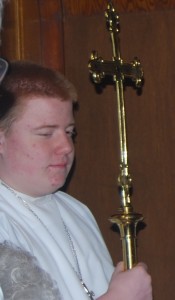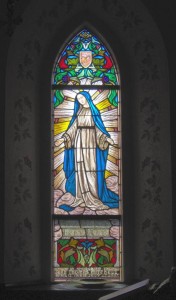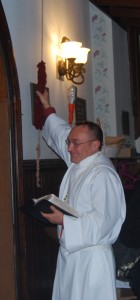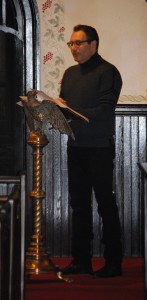Acolytes
The Episcopal Church of St. Clement St. Peter enjoys an active, vibrant group of acolytes. This group of dedicated volunteers assists the clergy by performing significant duties during religious services. Currently we are blessed to have five acolytes including our Acolyte Master, to take part in serving God on Sundays and for special services.
Acolyte Master
Tom Jamieson
Acolytes
Dorrance Daniels
Alexis McGrady
Aliyah McGrady
Tom Jamieson
Jerry Williams
Karen Zapotok
Their hard work and dedication is a vital and important part of our services.
Acolyte FAQ (Frequently Asked Questions)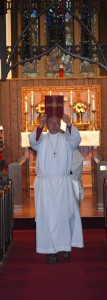
What is an acolyte?
An acolyte is also known as an altar server or an altar boy or girl. In fact, the origin of the word “acolyte” is from the Greek for “server.”
What does an acolyte do during the Sunday Service?
They carry the cross, torches, gospel, and sometimes banners during the procession. They assist the priest with setting the table for the communion or Eucharist. They receive the collections from the ushers and are responsible for the candles. They also may be called upon for special duties during the Christmas and Easter holidays.
Who can be an acolyte?
ANYONE! The beauty of being an acolyte is that anyone can help serve God. While acolytes are usually thought of being young men and women, any responsible person willing to sacrifice a little time can train to be an acolyte. Usually young people should be in at least 5th grade or 10 years old. However, depending on the maturity of the individual, a younger member may be allowed to join. This is up to the discretion of the Acolyte Master.
What is an Acolyte Master?
An Acolyte Master is an adult to whom responsibility for training and mentoring the Acolytes has been entrusted.
What about training?
Ou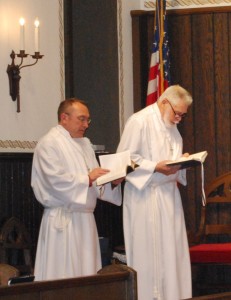 r Acolyte Master, Tom Jamieson, provides complete training for all of our acolytes. Each prospective acolyte will go through a preparation course to familiarize them with the duties involved. They will be given a handbook to keep and to study by. There is no set time period on training. Whether it takes 2 weeks or 2 months, an acolyte won’t be required to serve until she or he feels fully confident of the duties involved. A schedule will be mailed out periodically to acolytes to advise him or her the dates when they asked to serve.
r Acolyte Master, Tom Jamieson, provides complete training for all of our acolytes. Each prospective acolyte will go through a preparation course to familiarize them with the duties involved. They will be given a handbook to keep and to study by. There is no set time period on training. Whether it takes 2 weeks or 2 months, an acolyte won’t be required to serve until she or he feels fully confident of the duties involved. A schedule will be mailed out periodically to acolytes to advise him or her the dates when they asked to serve.
What do they wear?
An alb, or robe. This will be loaned to the acolyte for services. They will also wear a rope cincture around the waist and a cross.
What else do Acolytes do?
HAVE FUN! Yes, that’s right, being an acolyte is just not work, work, work. We like to do other things as a group to build up relationships and trust. In the past we have gone to the National Acolyte Festival at the National Cathedral in Washington, DC., enjoyed a Hockey game, and have been rewarded with gifts as tokens of appreciation for the fine job our acolytes do. Many additional events are in the planning stage to continue the aspect of fun and friendship for the Acolytes.
Choir
A choir is group of lay people that help lead the singing during a worship service and sometimes offer special anthems to enhance worship. The word “choir” can also used to define the chancel, the part of the church building where the choir sits.
New members are always welcome!
Organist & Choirmaster
Gina Sitler
Choir Members:
Dorrance Daniels
David Franks
Molly Franks
Tom Jaimeson
Chalice Administrators
Chalice Administrators are licensed by the Diocese for a period of two years and may be renewed for an additional two years. After two terms one year must pass before applying for a new license. The lay person is instructed by the priest to administer the chalice containing the consecrated wine at the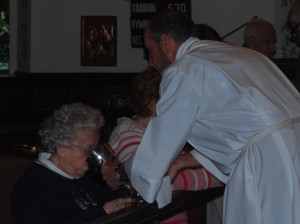 celebration of the Holy Eucharist. This is an important function which incorporates interested laity into the distribution of the Body and Blood of Christ.
celebration of the Holy Eucharist. This is an important function which incorporates interested laity into the distribution of the Body and Blood of Christ.
Chalice Administrators:
Dorrance Daniels
Liz Jamieson
Tom Jamieson
Jerry Williams
Karen Zapotok
Lay Eucharistic Ministers
A Lay Eucharistic Minister is licensed by the Diocese for three years after a period of instruction to take the Body and Blood of Christ to “homebound” “shut-ins” or hospitalized members of the parish who are not able to attend corporate worship in the Church.
Lay Eucharistic Ministers:
Vacant
Worship Leaders
A Licensed Lay Reader is a member of the congregation who has expressed an interest in being involved in the corporate worship of the church. After receiving instruction in the “Daily Offices” and the use of the Book of Common Prayer the rector evaluates their competency and recommends licensure by the Diocese. This license is valid for a three-year period and may be renewed at the request of the rector or lay reader
Our Worship Leaders:
Vacant
Lectors and Intercessors
These are two other areas in which the laity can take an active part in the 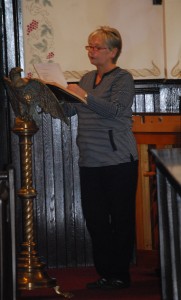 corporate worship of the church. Lectors are responsible for reading the Old Testament Lesson and the Epistle for the day and leading the congregation in reading the psalm in unison. Lectors are given the lessons for the day in advance so they can practice reciting and enunciating clearly. One does not have to be a “professional public speaker” but should feel comfortable reading aloud in public.
corporate worship of the church. Lectors are responsible for reading the Old Testament Lesson and the Epistle for the day and leading the congregation in reading the psalm in unison. Lectors are given the lessons for the day in advance so they can practice reciting and enunciating clearly. One does not have to be a “professional public speaker” but should feel comfortable reading aloud in public.
Intercessors are those individuals responsible for leading the congregation in the “Prayers of the People” (beginning on p.388 in Rite II, and on p. 328 in Rite I). In a church where there is a Deacon it is common practice for the Deacon to lead the Prayers of the People and the Confession with the Priest giving the concluding Collect at the Prayers and the Absolution after the Confession.
Our Lectors and Intercessors:
Brian Babonis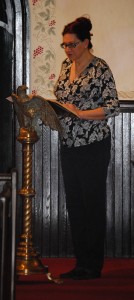
Jean Clocker
Dorrance Daniels
David Franks
Wilma Halstead
Tom Jamieson
Darren Ryan
Barbara Sepko
Betty St. Martin
Jerry Williams
John Zapotok
